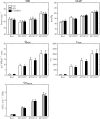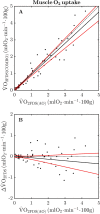Measurement of muscle blood flow and O2 uptake via near-infrared spectroscopy using a novel occlusion protocol
- PMID: 33441688
- PMCID: PMC7806775
- DOI: 10.1038/s41598-020-79741-w
Measurement of muscle blood flow and O2 uptake via near-infrared spectroscopy using a novel occlusion protocol
Abstract
We describe here a novel protocol that sequentially combines venous followed by arterial occlusions to determine muscle blood flow and O2 uptake from a single measurement point using near-infrared spectroscopy (NIRS) during handgrip exercise. NIRS data were obtained from the flexor digitorum superficialis (FDS) muscle on the dominant arm of 15 young, healthy adults (3 women; 26 ± 7 years; 78.6 ± 9.1 kg). Participants completed a series of 15-s static handgrip contractions at 20, 40 and 60% of maximal voluntary contraction (MVC) immediately followed by either a: (i) venous occlusion (VO); (ii); arterial occlusion (AO); or venous then arterial occlusion (COMBO). Each condition was repeated 3 times for each exercise-intensity. The concordance correlation coefficient (CCC) and robust linear mixed effects modeling were used to determine measurement agreement between vascular occlusion conditions. FDS muscle blood flow ([Formula: see text]) and conductance ([Formula: see text]) demonstrated strong absolute agreement between VO and COMBO trials from rest up to 60%MVC, as evidenced by high values for CCC (> 0.82) and a linear relationship between conditions that closely approximated the line-of-identity (perfect agreement). Conversely, although FDS muscle O2 uptake ([Formula: see text]) displayed "substantial" to "near perfect" agreement between methods across exercise intensities (i.e., CCC > 0.80), there was a tendency for COMBO trials to underestimate [Formula: see text] by up to 7%. These findings indicate that the COMBO method provides valid estimates of [Formula: see text] and, to a slightly lesser extent, [Formula: see text] at rest and during static handgrip exercise up to 60%MVC. Practical implications and suggested improvements of the method are discussed.
Conflict of interest statement
The authors declare no competing interests.
Figures





References
Publication types
MeSH terms
Grants and funding
LinkOut - more resources
Full Text Sources
Other Literature Sources

